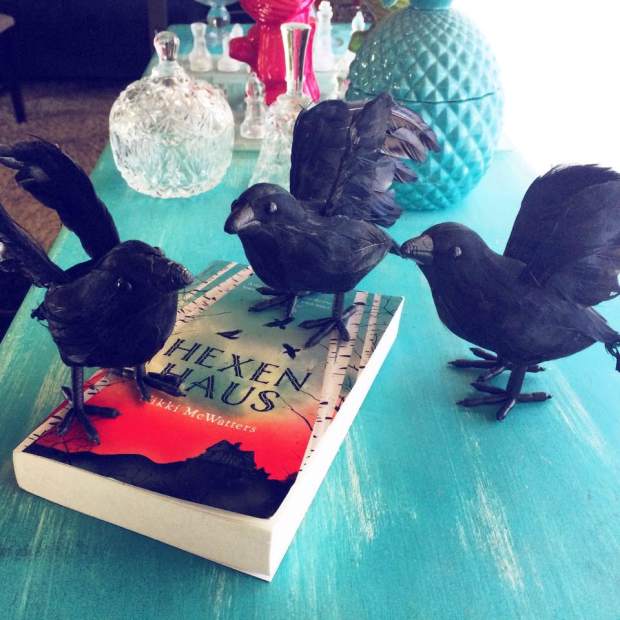‘Hexenhaus’, my new novel, was released today. The 31st October. 2016.
Most people have heard of the witch trials of Salem. They were the destructive outcome of dangerous folklore. But all across Europe, from Sweden to Germany, France, Spain and the UK, the idea of the ‘witch’ became the blame pigeon for epidemics, failed crops, birth defects and any manner of misfortune. The early European obsession with witches illustrated the cultural fear and fascination with women’s innate power which was shadowy and misunderstood. The female body summoned social anxiety because of its very power to give life. Women were viewed with suspicion and wariness.
In today’s world such attitudes and superstitions sound ludicrous but we live in a society that still argues about women’s reproductive rights and the pay gap. Domestic violence is a huge problem and one in three women will be sexually assaulted by a male during their lifetimes. The patriarchal stranglehold has not completely released its grip! When a male politician can stand in front of a placard reading ‘Ditch the Witch’, a reference to the female Prime Minister of his country, the stench of burning flesh and hair still wafts past him on the breeze, all the way from seventeenth century Salem and Europe.
I have been fascinated with witches since childhood (since Samantha Stephens of the television series Bewitched to be precise). In my new novel, Hexenhaus, based on historical characters and events, I aimed to transport readers back to a time when witches were fully believed to be real. It is hard for us looking through a contemporary lens to imagine a world where the sexism was so bad and the fear of the supernatural so intense, that people, even those of great learning, wholeheartedly believed that those accused and burned were actually witches. There were other political and religious motives at play in the later periods of persecution but these were times of which we can barely conceive. Hexenhaus was written to shine a light on those dark times.
Set in Bamberg, Germany in 1626 and Renfrewshire, Scotland 1697, two bookends of the seventeenth century, the historical threads of my narrative introduce Veronica Junius and Katherine Campbell, two young women inadvertently caught up in the witch hysteria of their time. Veronica escapes to a fairy-tale, idyllic existence in the woods which is her sacred and safe place, while Katherine finds herself confronted by a small child tormented by superstition so intensely that she sees her maids flying high in the sky at night, coming to visit her and poke her with pins while demanding that she give her soul over to the grim man in black. The accusations terrify the Renfrewshire community and Katherine must fight for her very life while enduring unspeakable tortures.
The modern thread of my story, the third strand in the braid, shows how hysteria is not confined to the darkest corners of history but still very much alive and well in our own back-yards. The witch-hunt in Bundanoon, Australia, portrayed in Hexenhaus, is a finely directed spotlight on how the media and politicians, spiritual leaders and neighbourhood-fence gossips can fan and fuel irrational fears into full-blown mass hysteria. Pick your folk devil ‘Muslims’ ‘homosexuals’ ‘single mothers’ ‘welfare recipients’ ‘people with tattoos’ and so on and so forth.. Early Europe had witches, Hitler had Jews, we have…..fill in your greatest fear here!
My brave characters of Veronica, Katherine and Paisley find themselves vulnerable to the bigotry and small-mindedness of those around them who are driven by fear and an intense hatred of things they do not understand.
‘Hexenhaus’ honours my female ancestors whose blood runs through my veins. My great great great great great grandmother was burned for being a witch. If you were to follow your mother-blood back through the ages you would all come across the same charred bones.
We are all sisters standing on the edge of the universe.
Those who suffered before me, persecuted as ‘witches’, bequeathed their strength that flows through my veins, their wisdom which has given me knowledge, their inspiration which has given birth to my new book Hexenhaus and I offer my book to the world as a way of showing my gratitude.
It is dedicated to my grandmother but also to every woman, man and child who lost their life so brutally at the gallows or at the burning stake, at the hands of a world driven mad by irrational fear.
We must be vigilant and never, ever let it happen again.
‘I fly through the candle’s mouth like a singeless moth.’ Sylvia Plath – Witch Burning.
